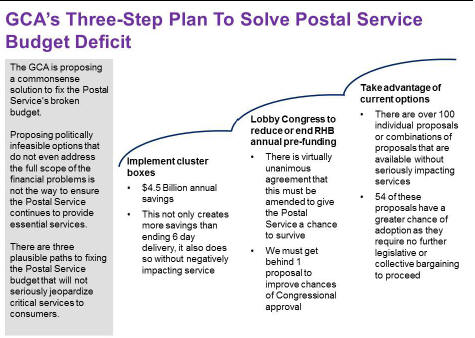The Greeting Card Association is the “U.S. trade association serving the greeting card and social expression industry. Founded in 1941, the GCA today represents nearly 200 American and international publishers from diverse businesses – ranging from young start-ups to established companies of all sizes, scopes and years in the industry – as well as suppliers that provide production services and product distribution at the wholesale level.”
The Hill reports that the Greeting Card Association is proposing its own version of postal reform.
A new report from the Greeting Card Association is pushing a plan to use cluster boxes for mail delivery, instead of the more expensive practice of delivering door-to-door.
The plan also calls for ending or vastly reducing the prepayments for retiree healthcare that USPS has defaulted on twice over the last year, to the tune of some $11 billon.
Under that proposal, policymakers could keep full Saturday delivery, and not increase postal rates faster than inflation – key interests for an industry that sees more than 60 percent of its product sent through the mail.
Read more: Greeting card industry releases postal reform plan – The Hill’s On The Money
Here are some pages from the Greeting Card Association report
First, the Postal Service should immediately implement cluster boxes on a widespread national scale using its existing management authority to do so, and drop politically divisive plans for Congress to end Saturday mail delivery
Second, the Postal Service should work with Congress to achieve a solution to the Retiree Health Benefits system (RHB) prefunding issue by amending the Postal Accountability and Enhancement Act (PAEA) and get this stand-alone legislation passed before the August recess;
Third, the Postal Service should evaluate the impact of the first two steps during the rest of this year and if more deficit reductions are needed, it should first draw from the list of 53 remaining proposals herein that it can implement under its existing management authority.
Cutting services is not the commonsense solution when there are so many other options available. The GCA has had a longstanding policy position that the best way to solve the Postal Service’s structural deficit and return it to solvency is to identify proposals that maintain universal service at affordable prices for every citizen throughout the country.

In 2003, congress passed a law which said that the Postal Service could not raise its rates to cover fuel costs. That’s right folks, the CPI index that the stamp price is chained to does NOT include energy costs. Since that time, how much has the price of gasoline increased? ONE HUNDRED PERCENT. Yup, it was $1.70 in 2003 and it is $3.50 or more now. So now you know the REAL reason why the Postal Service is bankrupt.
How’s about we install these cluster boxes and some criminal decides to hit you upside your head and take your mail? How about we do this and lose many more customers to the internet where you can order nearly anything and have it shipped and never have to walk to a cluster box to even care if you got mail? Seems the GCA doesn’t have a clue. Just like the rest of the federal government screwing people, the USPS should do so too?? Social Security recipients now MUST get direct deposit or a card, wonder what happens if they are robbed of that card, I wonder if the bank will protect the first $50 of a debit card, NOT. WE THE PEOPLE ARE LETTING OUR GOVERNMENT SCREW US OVER WITH CLAIMS OF SAVING MONEY. They might save money by direct depositing funds, but tell that to my mom who was robbed of her card and the thief stole all her money. What did she save? I had been taking her to the bank for ten years without incident, less than a year after getting the debit card, ROBBED!
How about placing around the entire building where the Greeting Card Assc. is located, cluster boxes.
Then with its daily delivery of mail they have to guess which box has today’s mail in it by walking about opening the cluster boxes until today’s treasures are found!
How about amortizing the prefunding of retiree health care over a 40-year period as was originally intended and not the 10-year schedule of its current structure.